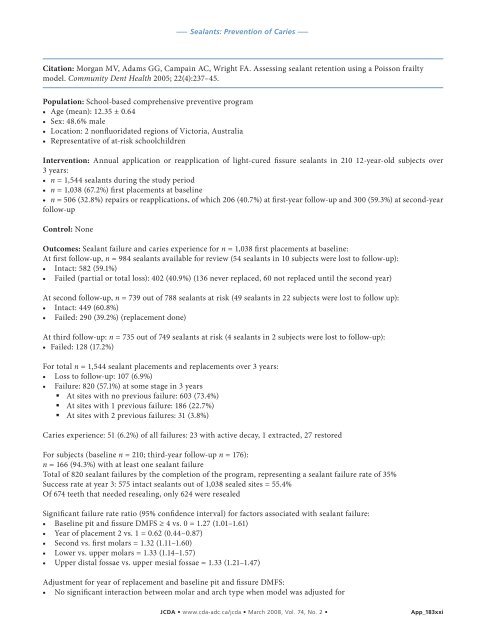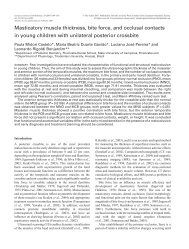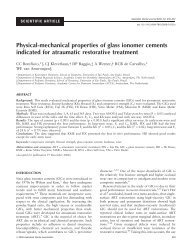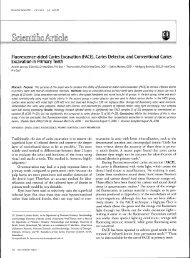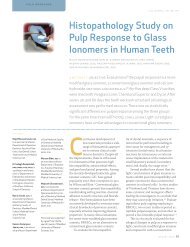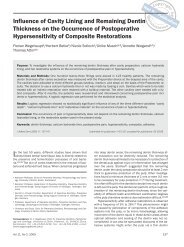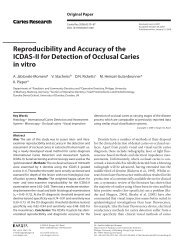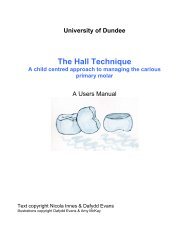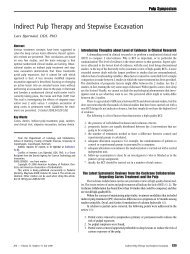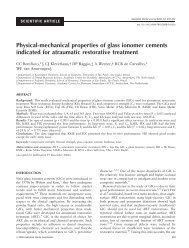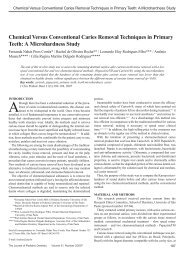Pit and Fissure Sealants in the Prevention of Dental Caries in ...
Pit and Fissure Sealants in the Prevention of Dental Caries in ...
Pit and Fissure Sealants in the Prevention of Dental Caries in ...
You also want an ePaper? Increase the reach of your titles
YUMPU automatically turns print PDFs into web optimized ePapers that Google loves.
––– <strong>Sealants</strong>: <strong>Prevention</strong> <strong>of</strong> <strong>Caries</strong> –––<br />
Citation: Morgan MV, Adams GG, Campa<strong>in</strong> AC, Wright FA. Assess<strong>in</strong>g sealant retention us<strong>in</strong>g a Poisson frailty<br />
model. Community Dent Health 2005; 22(4):237–45.<br />
Population: School-based comprehensive preventive program<br />
• Age (mean): 12.35 ± 0.64<br />
• Sex: 48.6% male<br />
• Location: 2 nonfluoridated regions <strong>of</strong> Victoria, Australia<br />
• Representative <strong>of</strong> at-risk schoolchildren<br />
Intervention: Annual application or reapplication <strong>of</strong> light-cured fissure sealants <strong>in</strong> 210 12-year-old subjects over<br />
3 years:<br />
• n = 1,544 sealants dur<strong>in</strong>g <strong>the</strong> study period<br />
• n = 1,038 (67.2%) first placements at basel<strong>in</strong>e<br />
• n = 506 (32.8%) repairs or reapplications, <strong>of</strong> which 206 (40.7%) at first-year follow-up <strong>and</strong> 300 (59.3%) at second-year<br />
follow-up<br />
Control: None<br />
Outcomes: Sealant failure <strong>and</strong> caries experience for n = 1,038 first placements at basel<strong>in</strong>e:<br />
At first follow-up, n = 984 sealants available for review (54 sealants <strong>in</strong> 10 subjects were lost to follow-up):<br />
• Intact: 582 (59.1%)<br />
• Failed (partial or total loss): 402 (40.9%) (136 never replaced, 60 not replaced until <strong>the</strong> second year)<br />
At second follow-up, n = 739 out <strong>of</strong> 788 sealants at risk (49 sealants <strong>in</strong> 22 subjects were lost to follow up):<br />
• Intact: 449 (60.8%)<br />
• Failed: 290 (39.2%) (replacement done)<br />
At third follow-up: n = 735 out <strong>of</strong> 749 sealants at risk (4 sealants <strong>in</strong> 2 subjects were lost to follow-up):<br />
• Failed: 128 (17.2%)<br />
For total n = 1,544 sealant placements <strong>and</strong> replacements over 3 years:<br />
• Loss to follow-up: 107 (6.9%)<br />
• Failure: 820 (57.1%) at some stage <strong>in</strong> 3 years<br />
At sites with no previous failure: 603 (73.4%)<br />
At sites with 1 previous failure: 186 (22.7%)<br />
At sites with 2 previous failures: 31 (3.8%)<br />
<strong>Caries</strong> experience: 51 (6.2%) <strong>of</strong> all failures: 23 with active decay, 1 extracted, 27 restored<br />
For subjects (basel<strong>in</strong>e n = 210; third-year follow-up n = 176):<br />
n = 166 (94.3%) with at least one sealant failure<br />
Total <strong>of</strong> 820 sealant failures by <strong>the</strong> completion <strong>of</strong> <strong>the</strong> program, represent<strong>in</strong>g a sealant failure rate <strong>of</strong> 35%<br />
Success rate at year 3: 575 <strong>in</strong>tact sealants out <strong>of</strong> 1,038 sealed sites = 55.4%<br />
Of 674 teeth that needed reseal<strong>in</strong>g, only 624 were resealed<br />
Significant failure rate ratio (95% confidence <strong>in</strong>terval) for factors associated with sealant failure:<br />
• Basel<strong>in</strong>e pit <strong>and</strong> fissure DMFS ≥ 4 vs. 0 = 1.27 (1.01–1.61)<br />
• Year <strong>of</strong> placement 2 vs. 1 = 0.62 (0.44–0.87)<br />
• Second vs. first molars = 1.32 (1.11–1.60)<br />
• Lower vs. upper molars = 1.33 (1.14–1.57)<br />
• Upper distal fossae vs. upper mesial fossae = 1.33 (1.21–1.47)<br />
Adjustment for year <strong>of</strong> replacement <strong>and</strong> basel<strong>in</strong>e pit <strong>and</strong> fissure DMFS:<br />
• No significant <strong>in</strong>teraction between molar <strong>and</strong> arch type when model was adjusted for<br />
JCDA • www.cda-adc.ca/jcda • March 2008, Vol. 74, No. 2 • App_183xxi


